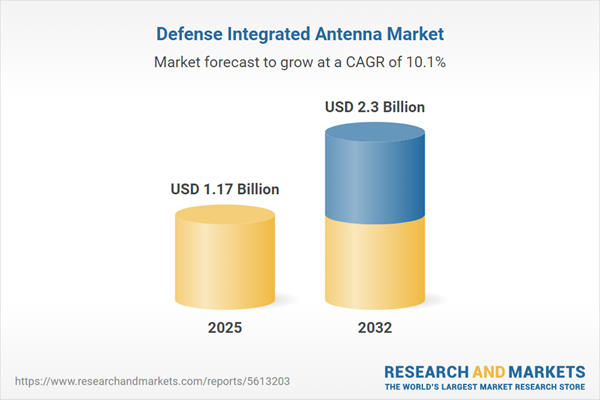Speak directly to the analyst to clarify any post sales queries you may have.
Defense integrated antenna systems create the secure communication backbone essential for modern military operations, empowering organizations to operate effectively in today’s fast-changing and high-risk environments. These solutions provide the capability and flexibility required by defense leaders managing complex transformation, digital modernization, and cybersecurity priorities.
Market Snapshot: Growth of the Defense Integrated Antenna Market
The global defense integrated antenna market is undergoing rapid expansion, driven by continuous modernization and evolving digital defense strategies. In 2024, the sector is valued at USD 1.06 billion and is projected to reach USD 1.17 billion in 2025, achieving USD 2.30 billion by 2032 with a compound annual growth rate of 10.09%. Increasing investments in secure mission communications, improvements in data protection, and requirements for uninterrupted operational command are key forces shaping the market. Organizations worldwide are focusing on developing multi-mission platforms that enable greater interoperability and readiness in unpredictable operational scenarios.
Scope & Segmentation of the Defense Integrated Antenna Market
The defense integrated antenna market is defined by a range of segments that guide effective investment and capability development for defense stakeholders.
- Platforms: Airborne systems focus on high-speed, stable connectivity. Ground operations benefit from antennas designed for mobility and durability. Naval deployments require integration with radar technology and robust maritime communication links. Space-based platforms emphasize signal resilience to support satellite mission integrity.
- Technologies: Mechanically scanned arrays are incorporated for equipment compatibility, while phased array solutions provide agile beam direction and operational versatility. Optical antennas enable fast, secure data transfers with enhanced protection from intentional interference. Radio frequency architectures guarantee network compatibility across defense vehicles and command posts.
- Frequencies: Bands such as C, Ka, Ku, L, S, and X are employed to serve vital operational tasks like secure command transmission, real-time surveillance, and specialized radar functions.
- Applications: These systems support secure communications, electronic warfare, high-precision surveillance, radar-based targeting, trusted geospatial positioning, and telemetry, improving situational awareness at every command level.
- End Users: Key users include armed forces, governmental defense agencies, and systems integrators, each seeking next-generation performance and responsiveness.
- Geographic Regions: The Americas prioritize fleet modernization initiatives. Europe emphasizes interoperability to enhance alliance operations. The Middle East invests in adaptable and secure communications, while Asia-Pacific rapidly adopts new platforms. African stakeholders seek network flexibility tailored to regional constraints.
- Leading Companies: Market influencers include L3Harris Technologies, Raytheon Technologies, Lockheed Martin, Northrop Grumman, BAE Systems, Thales, Leonardo, Elbit Systems, Saab AB, and Cobham Limited, each contributing technical advancements and robust supply solutions.
Key Takeaways for Senior Decision-Makers
- Ongoing advancements in digital processing and radio frequency design equip defense organizations to respond to evolving mission scenarios and accelerate deployment cycles.
- Transitioning to modular, open-architecture antenna frameworks supports seamless system upgrades, minimizes total ownership costs, and strengthens adaptability.
- Adoption of software-defined antenna systems reinforces critical network security, offering resilient connectivity against sophisticated electronic disruptions.
- Collaboration between technology manufacturers, system integrators, and software specialists enables faster innovation cycles and improved operational resilience within defense frameworks.
- Growth in regional manufacturing capacity and use of additive production processes builds supply chain robustness vital for secure and uninterrupted defense operations.
- Procurement approaches are increasingly tailored at the regional level, allowing leaders to balance modernization, interoperability, and fiscal priorities based on unique theater requirements.
Tariff Impact: United States Tariffs on Defense Antenna Components
Current United States tariffs on imported antenna components are prompting defense sector organizations to scale domestic production and diversify partnerships, especially with European and Asian suppliers. This changing environment is driving adoption of modular, multi-source components, granting procurement teams greater flexibility and risk mitigation. Both manufacturers and government agencies are improving supply chain resilience to better anticipate and respond to future market demands.
Methodology & Data Sources
This report is based on direct contributions from senior defense leaders, leading industry players, and dedicated procurement professionals. All findings are supported by verified procurement records and technical validation to provide reliable guidance for defense integrated antenna system investments.
Defense Integrated Antenna Market: Why This Report Matters
- Helps define investment priorities in antenna technologies fundamental to modern defense strategies.
- Offers guidance for managing regulatory shifts and complex supply chain challenges amid global changes.
- Delivers recommendations to advance digitalization, increase cross-sector collaboration, and improve operational effectiveness across the defense ecosystem.
Conclusion
Integrated antenna systems strengthen the foundation for dependable military communications. This report delivers actionable insights, enabling defense organizations to advance readiness and strategic goals in challenging and evolving operational settings.
Additional Product Information:
- Purchase of this report includes 1 year online access with quarterly updates.
- This report can be updated on request. Please contact our Customer Experience team using the Ask a Question widget on our website.
Table of Contents
3. Executive Summary
4. Market Overview
7. Cumulative Impact of Artificial Intelligence 2025
Companies Mentioned
The companies profiled in this Defense Integrated Antenna market report include:- L3Harris Technologies, Inc.
- Raytheon Technologies Corporation
- Lockheed Martin Corporation
- Northrop Grumman Corporation
- BAE Systems plc
- Thales S.A.
- Leonardo S.p.A.
- Elbit Systems Ltd.
- Saab AB
- Cobham Limited
Table Information
| Report Attribute | Details |
|---|---|
| No. of Pages | 194 |
| Published | October 2025 |
| Forecast Period | 2025 - 2032 |
| Estimated Market Value ( USD | $ 1.17 Billion |
| Forecasted Market Value ( USD | $ 2.3 Billion |
| Compound Annual Growth Rate | 10.0% |
| Regions Covered | Global |
| No. of Companies Mentioned | 11 |









